- HOME
- Domestic and International Cooperation
- The University of Tübingen in Germany, Neurospin in France, and Bruker Corporation in Germany
Report on the international cooperation network
(The University of Tübingen in Germany, Neurospin in France, and Bruker Corporation in Germany)
Norihiro Sadato
Professor at Division of Cerebral Integration, Department of System Neuroscience, National Institute for Physiological Sciences
Advanced Bioimaging Support
sadato@nips.ac.jp
[Schedule] October 9, 2016 - October 16, 2016
[Destination] The University of Tübingen (Germany), Neurospin (France), and Bruker Corporation (Germany)
[Outline]
The objectives of the visit were to collect information and networking about the latest technology on Magnetic Resonance Imaging for humans and test animals, to upgrade the support content for ABiS: Advanced Bioimaging Support, Grant-in-Aid for Scientific Research on Innovative Areas―Platforms for Advanced Technologies and Research Resources. I visited The University of Tübingen in Germany; a leading research facility specializes in ultra-high field MRI, Neurospin in France; a research institution established under French Alternative Energies and Atomic Energy Commission, and Bruker Corporation in Germany; a manufacturer of Magnetic Resonance devices. Our discussions were focused on the technology using the ultra-high field MRI hardware for test animals.
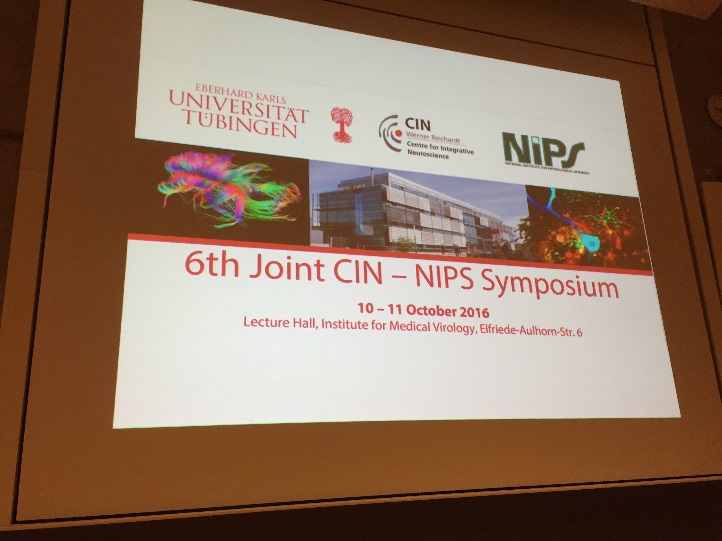
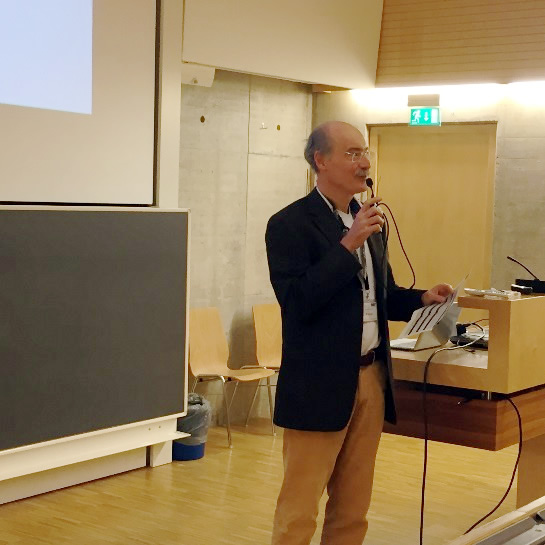
Picture 1: First presentation slide (left) and Professor Thier
[Itinerary]
I attended the 6th CIN-NIPS Symposium held in the The Werner Reichardt Centre for Integrative Neuroscience (CIN), The University of Tübingen in Tübingen, Germany for two days from October 10 to October 11. (Picture 1)
The University of Tübingen is one of the most renowned German neuroscience research hub facilities, consisting of seven departments with 500 faculties (professor), and 25,500 students. The Werner Reichardt Centre for Integrative Neuroscience has 72 senior research scientists and 300 students.
CIN-NIPS Symposium is held every year based on the Memorandum of Understanding signed by CIN and NIPS aiming to foster scientific cooperation. They take turns to visit each other’s country. This year, a group of researchers from NIPS visit The University of Tübingen.
The Symposium started at 9:50 a.m., Professor Thier of The University of Tübingen and Professor Nambu of NIPS made keynote addresses. Professor Isa who transferred from NIPS to Kyoto University and who served the mutual collaboration talked about the importance of the long-term mutual research cooperation. The two-day symposium had oral presentations and poster sessions primarily focusing on system neuroscience. With a sufficient time and in the relaxed mood, the discussions were facilitated well that made the symposium significant.
Dr. Scheffler of the The University of Tübingen reported on the specific usability of the ultra-high field MRI (9.4T) that showed the usability of balanced SSFP to measure cerebral blood volume. This report facilitated the exchange between Dr. Scheffler and Associate Professor Fukunaga of NIPS to introduce the technique to NIPS.
We spent all day on October 12 moving from Germany to France, on October 13, we visited Neurospin in Paris, France. (Picture 2)
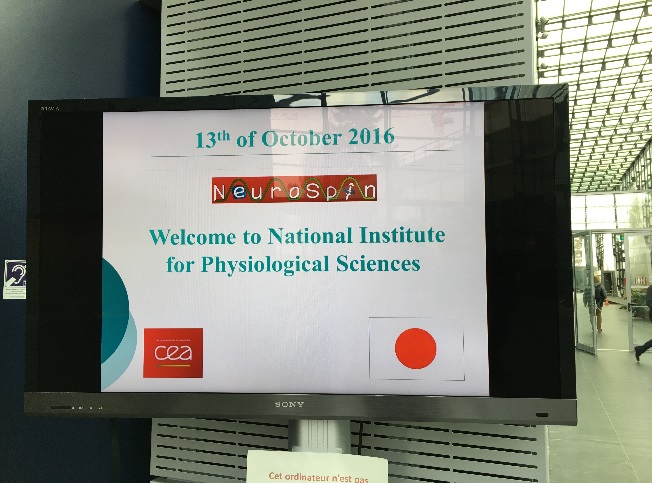
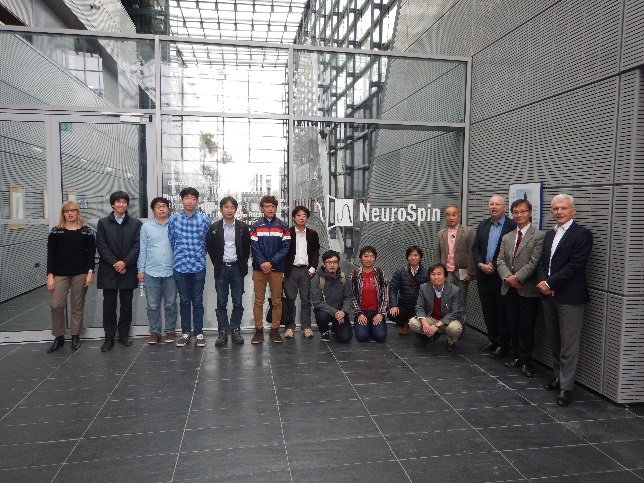
Picture 2: Welcome bulletin board (left) at NueroSpin, and a group photo (the third person from the right is Director Le Bihan and I am on his right)
Neurospin is a research institute in the Life Sciences Division of the CEA (French Alternative Energies and Atomic Energy Commission). CEA is a governmental organization in charge of the energy administration in France. It has four research sections with about 15,000 staffs in total.
Since it established in 2007, Neurospin has cutting-edge expertise in neuroscience research using 3 tesla and 7 tesla human MRI scanners. Also the institute has an extremely high-level technology such as to develop 11.7 tesla human MRI scanners.
During the visit, the researchers of NIPS and NeuroSpin introduced their research themes in turn, Dr. Denis Le Bihan (Director of NeuroSpin) himself guided us to 3 tesla and 7 tesla human MRI scanners as well as the currently developing 11.7 tesla scanner. Further, he showed us the experimental approach using ultra-high field MRI for test animals. Prof. Nabekura (Vice-Director-General of NIPS), Dr. Denis Le Bihan and I discussed the future research exchange in detail based on the Memorandum of Understanding signed by NIPS and NueroSpin this year.
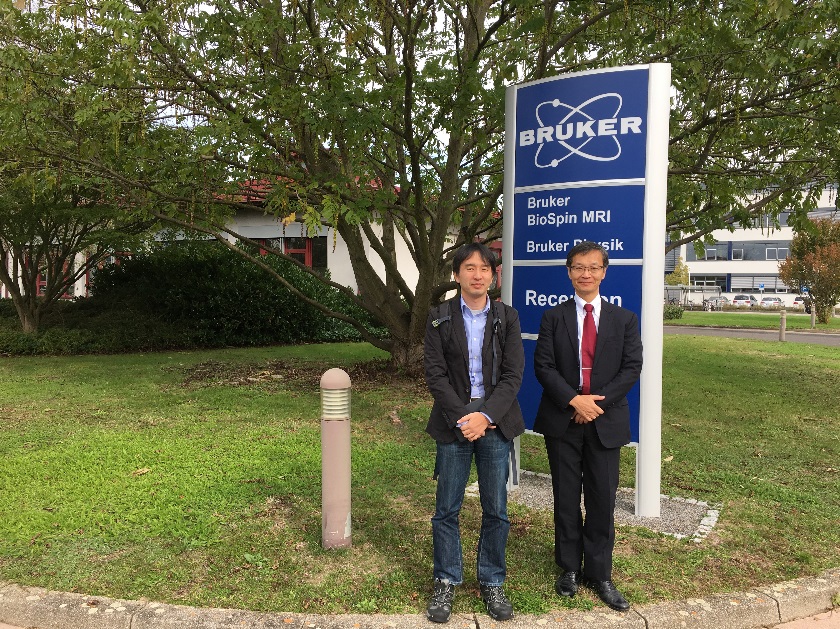
Picture 3: Associate Professor Fukunaga (left)
and me at the head office of Bruker Corporation.
We moved to Karlsruhe from the neighboring city of Ettringen overland on the 13th, next day, October 14th, we visited Bruker Corporation in Ettringen, Germany (Picture 3). Bruker Corporation is a leading company to manufacture and develop MRI scanners for animals and installed more than 600 devices all over the world. The company has a factory in France and the head office in Germany. We first visited its factory in Wissembourg, France to see the manufacturing site to produce the high magnetic field magnets and a gradient magnetic field coils. Our group had a meeting with the CEO the Chairman, President and the Vice President to discuss on the importance of MRI devices for animals in the future research in Imaging Science. We participated in the experiment on the site using ultra-high-speed imaging device on a mouse and later discussed with the researchers about the specific issues for the technique.
[Effect]
The brain science has been rapidly shifting its focus from the conventional observation on the cells to the functional observation to inspect the brain function as a whole, thanks to the advancement of cerebral function imaging and other technologies.
For Japan to take a lead worldwide in the most advanced research fields, NIPS strive to proceed with the following projects as an inter-university research institute having the ultra-high field MRI installed.
We construct the foundation of the MRI research by forming a network with the domestic and international research institutions. We offer our service to the nationwide universities. We also foster human resources who can operate and make full use of the ultra-high field MRI. (Project of the Request of the Budget: Elucidate the human highly brain function by the mutual collaborative research using ultra-high magnetic field resonance imaging device in Fiscal Year of 2016-2021). NIPS signed the Memorandum with The University of Tübingen and Neurospin, our important collaborative bases, to promote mutual collaborative academic researches. This visit was a part of the promotion activities, at the same time it aimed to improve the advanced bioimaging support content that NIPS leads in “Advanced Bioimaging Support”. By collecting information of the latest trend of MRI technology for humans and test animals, and establishing a network with the key persons, I expect to develop more seamless technical cooperation.






